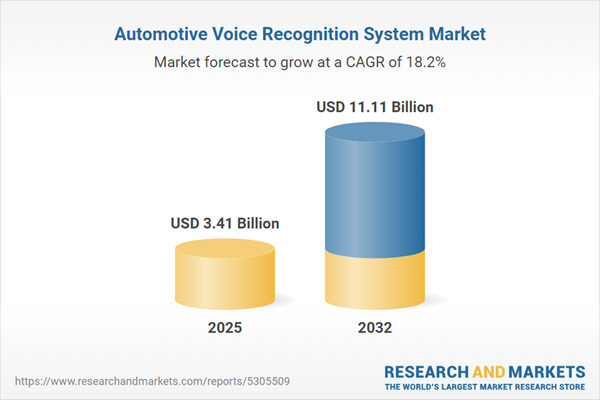Speak directly to the analyst to clarify any post sales queries you may have.
Automotive voice recognition systems are rapidly transforming in-vehicle interactions, facilitating hands-free commands and enhancing both safety and user experience. This report provides senior decision-makers with a high-impact overview of current market trends, segmentation, and actionable insights for navigating the evolving automotive technology ecosystem.
Market Snapshot: Automotive Voice Recognition System Market Overview
The Automotive Voice Recognition System Market grew from USD 2.90 billion in 2024 to USD 3.41 billion in 2025. It is expected to continue growing at a CAGR of 18.23% and reach USD 11.11 billion by 2032. This growth reflects heightened demand for seamless dashboard interaction, sophisticated infotainment, and advanced driver assistance integration. Cloud connectivity, edge computing, and natural language processing are driving innovation as industry players intensify their focus on convenience, safety, and regulatory compliance.
Scope & Segmentation
This comprehensive research analyzes trends and revenue forecasts across multiple segments and regions, prioritizing depth and applicability for strategic planning. The scope includes:
- Type of Voice Recognition System: Cloud-based, embedded, and hybrid systems with different infrastructure needs.
- Component: Hardware modules such as sensor arrays and processing chips alongside advanced software platforms.
- Technology: Natural language processing, speech recognition, and voice biometrics for secure authentication and contextual understanding.
- Connectivity: Bluetooth-powered, cellular-enabled, and Wi-Fi-based systems affecting data transfer and latency.
- Application: Solutions used in climate control, driver assistance, infotainment, safety and security, telematics, navigation, and system control.
- Vehicle Type: Commercial vehicles (including heavy and light duty), as well as passenger cars.
- Sales Channel: Aftermarket and original equipment manufacturer models shaping end-user adoption.
- Region: Detailed coverage of the Americas (United States, Canada, Mexico, Brazil, Argentina, Chile, Colombia, Peru), Europe, Middle East & Africa (including United Kingdom, Germany, France, Russia, Italy, Spain, Netherlands, Sweden, Poland, Switzerland, United Arab Emirates, Saudi Arabia, Qatar, Turkey, Israel, South Africa, Nigeria, Egypt, Kenya), and Asia-Pacific (China, India, Japan, Australia, South Korea, Indonesia, Thailand, Malaysia, Singapore, Taiwan).
- Key Companies: In-depth review of industry leaders such as Alpine Electronics, Amazon Web Services, Apple, Aptiv, BMW AG, Cerence, Continental, Denso, Faurecia Clarion Electronics, Ford, Google, Hyundai, iFLYTEK, Magneti Marelli, Mercedes-Benz Group, Microsoft, Nuance Communications, Panasonic Automotive Systems, Robert Bosch, Samsung Electronics, Sensory, SoundHound AI, Tesla, Visteon, and VoiceBox Technologies.
Key Takeaways
- Pivotal advances in voice recognition leverage deep learning and neural networks, enabling systems to process complex commands and multiple languages effortlessly.
- Hands-free convenience and personalization have become baseline user expectations, prompting integration of natural language and context-aware interactions in both premium and entry segments.
- The fusion of cloud and edge architectures optimizes performance, ensuring real-time processing and reliability even under inconsistent connectivity conditions.
- Regulatory trends aimed at reducing driver distraction are accelerating the adoption of adaptive wake-word detection, robust noise cancellation, and secure voice biometrics.
- Regional strategies differ, with North America emphasizing luxury features, Europe focusing on regulatory compliance and urban mobility, and Asia-Pacific driving mass-market accessibility and localized innovation.
- Collaboration among OEMs, semiconductor firms, and technology providers is critical in rapidly translating emerging technology into commercially resilient offerings.
Tariff Impact: Navigating Supply Chain and Sourcing Challenges
Expected 2025 United States tariff measures have prompted automotive voice recognition stakeholders to reconsider both sourcing strategies and cost management. Many OEMs are now prioritizing regional manufacturing, reducing exposure to supply chain disruptions and tariff-related expenses. Software firms are exploring modular licenses and localized data centers to sustain operational flexibility. This trend toward regional clusters and manufacturing alliances is reshaping cost structures and supply resilience throughout the industry.
Methodology & Data Sources
This report combines secondary research from industry reports, patents, and regulatory filings with primary interviews of automotive OEMs, suppliers, and technology vendors. Qualitative insights are verified through quantitative surveys and lab-based sensor testing. Regional expert consultation ensures the analysis reflects localized regulatory and infrastructure factors.
Why This Report Matters
- Enables C-suite leaders and product strategists to benchmark competitive positioning and refine go-to-market plans based on granular segmentation.
- Highlights the strategic imperatives—technology readiness, regulatory compliance, and ecosystem partnership—for differentiation and growth in voice recognition.
- Offers practical recommendations to accelerate technology adoption and investment focus for lasting impact.
Conclusion
The automotive voice recognition market is advancing rapidly across technology, regulation, and user adoption fronts. Strategic investments aligning modular system development, localized manufacturing, and cross-industry alliances will best position organizations for success in this evolving landscape.
Additional Product Information:
- Purchase of this report includes 1 year online access with quarterly updates.
- This report can be updated on request. Please contact our Customer Experience team using the Ask a Question widget on our website.
Table of Contents
3. Executive Summary
4. Market Overview
7. Cumulative Impact of Artificial Intelligence 2025
Companies Mentioned
The companies profiled in this Automotive Voice Recognition System market report include:- Alpine Electronics, Inc.
- Amazon Web Services, Inc.
- Apple Inc.
- Aptiv PLC
- Bayerische Motoren Werke AG (BMW AG)
- Cerence Inc.
- Continental Aktiengesellschaft
- Denso Corporation
- Faurecia Clarion Electronics Co., Ltd.
- Ford Motor Company
- Google LLC
- Hyundai Motor Company
- iFLYTEK Co., Ltd.
- Magneti Marelli S.p.A.
- Mercedes-Benz Group AG
- Microsoft Corporation
- Nuance Communications, Inc.
- Panasonic Automotive Systems Company
- Robert Bosch GmbH
- Samsung Electronics Co., Ltd.
- Sensory, Inc.
- SoundHound AI, Inc.
- Tesla, Inc.
- Visteon Corporation
- VoiceBox Technologies Corporation
Table Information
| Report Attribute | Details |
|---|---|
| No. of Pages | 193 |
| Published | November 2025 |
| Forecast Period | 2025 - 2032 |
| Estimated Market Value ( USD | $ 3.41 Billion |
| Forecasted Market Value ( USD | $ 11.11 Billion |
| Compound Annual Growth Rate | 18.2% |
| Regions Covered | Global |
| No. of Companies Mentioned | 26 |









